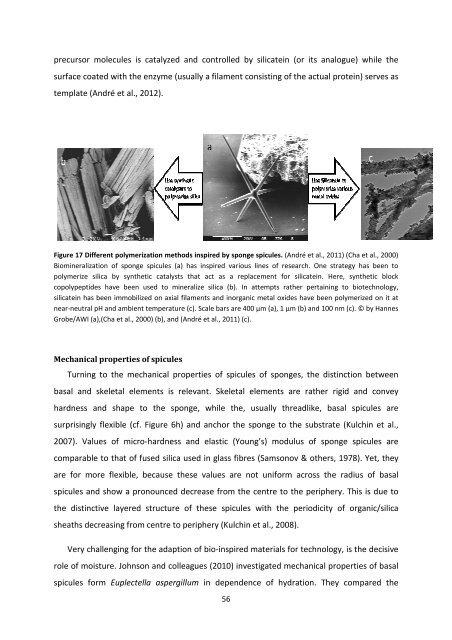MASTER THESIS Biomimetic potential of sponge ... - IAP/TU Wien
MASTER THESIS Biomimetic potential of sponge ... - IAP/TU Wien
MASTER THESIS Biomimetic potential of sponge ... - IAP/TU Wien
You also want an ePaper? Increase the reach of your titles
YUMPU automatically turns print PDFs into web optimized ePapers that Google loves.
precursor molecules is catalyzed and controlled by silicatein (or its analogue) while the<br />
surface coated with the enzyme (usually a filament consisting <strong>of</strong> the actual protein) serves as<br />
template (André et al., 2012).<br />
Figure 17 Different polymerization methods inspired by <strong>sponge</strong> spicules. (André et al., 2011) (Cha et al., 2000)<br />
Biomineralization <strong>of</strong> <strong>sponge</strong> spicules (a) has inspired various lines <strong>of</strong> research. One strategy has been to<br />
polymerize silica by synthetic catalysts that act as a replacement for silicatein. Here, synthetic block<br />
copolypeptides have been used to mineralize silica (b). In attempts rather pertaining to biotechnology,<br />
silicatein has been immobilized on axial filaments and inorganic metal oxides have been polymerized on it at<br />
near-neutral pH and ambient temperature (c). Scale bars are 400 µm (a), 1 µm (b) and 100 nm (c). © by Hannes<br />
Grobe/AWI (a),(Cha et al., 2000) (b), and (André et al., 2011) (c).<br />
Mechanical properties <strong>of</strong> spicules<br />
Turning to the mechanical properties <strong>of</strong> spicules <strong>of</strong> <strong>sponge</strong>s, the distinction between<br />
basal and skeletal elements is relevant. Skeletal elements are rather rigid and convey<br />
hardness and shape to the <strong>sponge</strong>, while the, usually threadlike, basal spicules are<br />
surprisingly flexible (cf. Figure 6h) and anchor the <strong>sponge</strong> to the substrate (Kulchin et al.,<br />
2007). Values <strong>of</strong> micro-hardness and elastic (Young’s) modulus <strong>of</strong> <strong>sponge</strong> spicules are<br />
comparable to that <strong>of</strong> fused silica used in glass fibres (Samsonov & others, 1978). Yet, they<br />
are for more flexible, because these values are not uniform across the radius <strong>of</strong> basal<br />
spicules and show a pronounced decrease from the centre to the periphery. This is due to<br />
the distinctive layered structure <strong>of</strong> these spicules with the periodicity <strong>of</strong> organic/silica<br />
sheaths decreasing from centre to periphery (Kulchin et al., 2008).<br />
Very challenging for the adaption <strong>of</strong> bio-inspired inspired materials for technology, is the decisive<br />
role <strong>of</strong> moisture. Johnson and colleagues (2010) investigated mechanical properties <strong>of</strong> basal<br />
spicules form Euplectella aspergillum in dependence <strong>of</strong> hydration. They compared the<br />
56

















